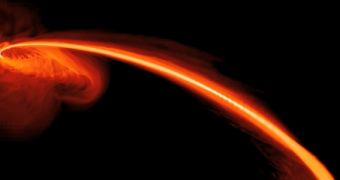A team of astronomers was recently able to develop a new computer simulation of how black holes about the size of the one at the core of the Milky Way are able to shred and destroy their stellar companions. For this work, scientists used data from a multitude of ground- and space-based telescopes, including the NASA Chandra X-ray Observatory (CXO).
The image above is a snapshot from the simulation software. It reveals a large amount of material being torn apart from a star that is located outside this field of view and then channeled towards the black hole, which can be seen as a tiny black dot to the upper left of the photo. The computer model also reveals the type of turbulences that occur as material flows into such a dark behemoth.
Researchers also point out that an important amount of material that has been removed from the star is not being absorbed by the black hole through its accretion disk, but it is rather cast out into space at a very high speed. The team explains that the two objects were most likely not a part of the same initial binary system. It is possible that the star just ran out of luck when coming too close to the black hole.
The system this simulation is based upon is very real and is located in the galaxy PS1-10jh. This structure is relatively far away, at some 2.7 billion light-years from Earth. The shredding of the unfortunate star has been observed with the NASA Galaxy Evolution Explorer (GALEX) orbiter, the Pan-STARRS1 telescope on Haleakala, in Hawaii, and the CXO.
The fact that the black hole is destroying a nearby star was observed by accident, when astronomers discovered a flare of light at ultraviolet and optical wavelengths, coming from this system. This light is produced by friction in the accretion disk around the black hole, which heats up material to several millions of degrees, forcing it to emit radiation.
Additional light is also being produced by the gas that is being cast away from the black hole. Experts used Chandra in order to establish for a fact that this was indeed an instance of black hole cannibalism and not a simple flare-up of a distant, active galactic nucleus (AGN). Upon studying the characteristics of the gas flows, the sensitive telescope determined that that was not the case.
According to the research group, the black hole in PS1-10jh tips the scales at around several million solar masses. This means that it is roughly the same size as Sagittarius A*, the supermassive black hole at the core of the Milky Way. Astronomers say that they can now use the distant object as a laboratory, to determine what would happen at the core of our own galaxy is such an event were to occur.

 14 DAY TRIAL //
14 DAY TRIAL //